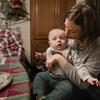FRIL Toolkit for People with Disabilities and Family Members
The Families Reimagining Inclusive Lives (FRIL) Toolkit is resource for parents of school-aged children with disabilities. This toolkit provides a wide range of information and guidance that parents can use in everyday life and throughout their child’s lifespan.

